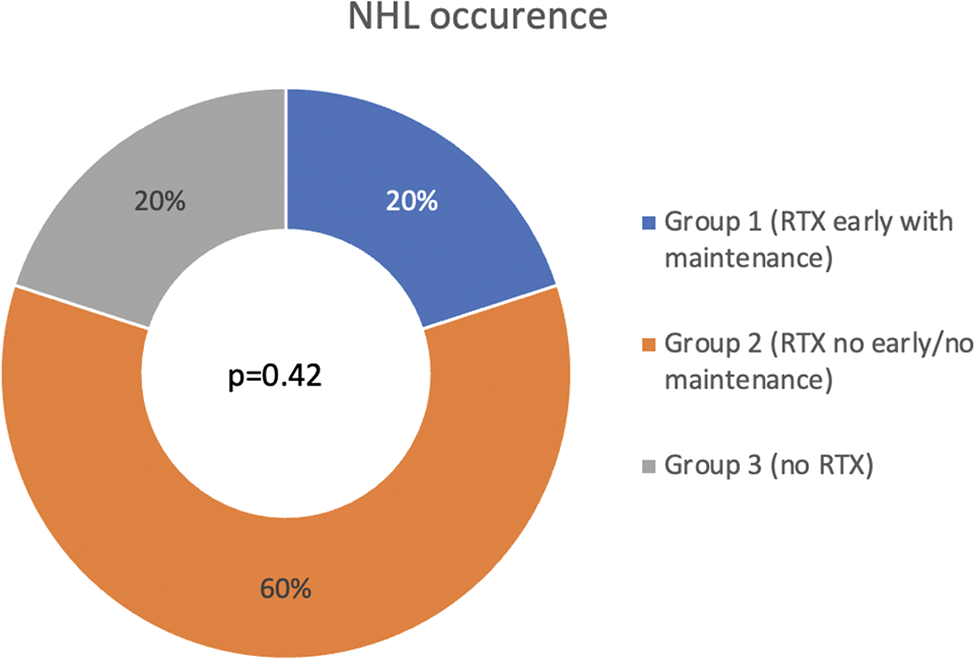

Background: Cryoglobulinemic vasculitis in primary Sjögren’s syndrome (pSS-CryoVasc) is a specific phenotype marked by B-cell lymphoproliferation and immunocomplex-mediated vasculitis affecting skin, nerves, joints and kidneys. With a prevalence of 3-10% among pSS, pSS-CryoVasc is linked to high clinical and biological disease activity, increased morbidity, and mortality. The link between CryoVasc and pSS involves pronounced B-cell activation, leading to salivary MALT lymphoproliferation and a significantly elevated risk of non-Hodgkin lymphoma (NHL) development. In the context of CryoVasc, Rituximab (RTX) has shown efficacy in controlling lymphoproliferation and associated manifestations. However, its safety, effectiveness, and optimal therapeutic regimen in the specific pSS-CryoVasc subset remain unclear.
Objectives: To compare safety and efficacy of two different Rituximab (RTX)-based therapeutic approaches on vasculitic and lymphoproliferative-related disease activity and on Non-Hodgkin Lymphoma (NHL) development in a cohort of patients affected by pSS-CryoVasc.
Methods: pSS-CryoVasc patients followed from January 1999 with an active follow-up in August 2023 were selected. 3 groups were identified: 1) Early RTX induction followed by maintenance; 2) Late RTX induction with possible on-demand retreatment; 3) No RTX treatment. For each group it was evaluated from pSS-CryoVasc diagnosis to last assessment: a) changes in disease activity according to the overall ESSDAI score related to vasculitis and lymphoproliferation and to each ESSDAI domain related to the same manifestations; b) the development of NHL; c) the occurrence of persistent hypogammaglobulinemia and serious infections.
Results: 13 pSS-CryoVasc patients were identified: 1) 5/13 treated earlier with RTX with subsequent maintenance; 2) 5/13 treated late with RTX with possible on-demand retreatment; 3) 3/13 not treated with RTX. A significant decrease in total ESSDAI considering domains related to vasculitic and lymphoproliferative manifestations was highlighted in the two RTX groups, with group 1 showing the most substantial reduction (median -17 vs -4 vs 7; H=6.55; p=0.03). Regarding CV-related ESSDAI domains (cutaneous, PNS, articular) a significant improvement was observed among patients receiving RTX vs patients not receiving RTX (p=0.007; p=0.006; p=0.03; respectively) while no difference was noted between patients receiving the two distinct RTX-based regimens. Considering lymphoproliferative-related ESSDAI domains no improvement was observed between those undergoing RTX and those not undergoing RTX, however, when evaluating the two RTX schemes an improvement in the glandular and nodal ESSDAI was noted in patients of group 1 (p=0.03; p=0.03, respectively). No significant differences among NHL occurrence (p=0.42) or safety concerns (p=1) were observed among the groups.
Conclusion: RTX is an effective and safe treatment to control pSS-CryoVasc disease activity with a greater impact when administered early with a subsequent maintenance regimen (Figure 1); whilst an on-demand RTX strategy is sufficient to control vasculitic manifestations, a more aggressive approach is required to control lymphoproliferative disease activity. However, RTX alone cannot affect the possible development of an overt NHL in pSS-CryoVasc (Figure 2). These preliminary findings support the use of RTX in pSS-CryoVasc emphasizing the importance of precise stratification of these patients to ensure them a tailored and effective treatment.
REFERENCES: [1] Quartuccio L et al. Cryoglobulinemia in Sjögren Syndrome: A Disease Subset that Links Higher Systemic Disease Activity, Autoimmunity, and Local B Cell Proliferation in Mucosa-associated Lymphoid Tissue. J Rheumatol. 2017;44(8):1179-1183.
[2] Quartuccio L, et al. Management of mixed cryoglobulinemia with rituximab: evidence and consensus-based recommendations from the Italian Study Group of Cryoglobulinemia (GISC). Clin Rheumatol. 2023;42(2):359-370.
Overall ESSDAI reduction...

NHL occurrence into the...

Acknowledgements: NIL.
Disclosure of Interests: None declared.